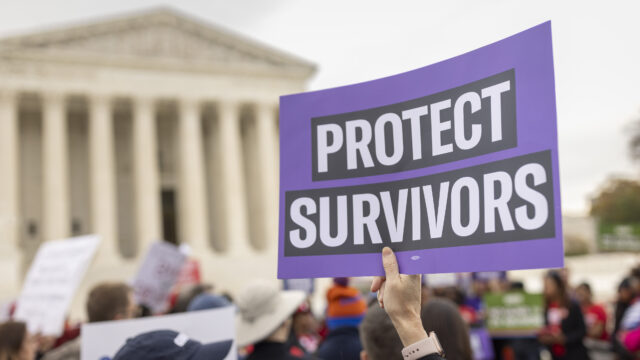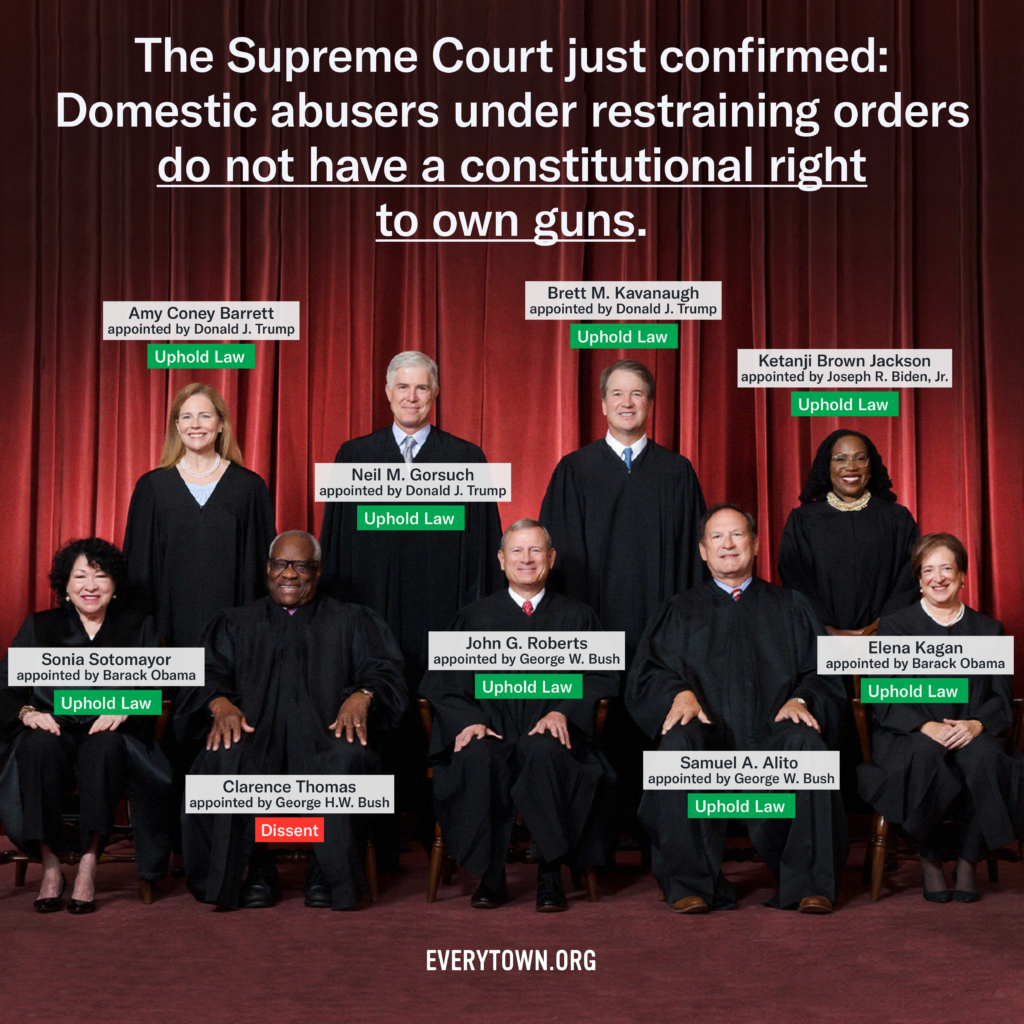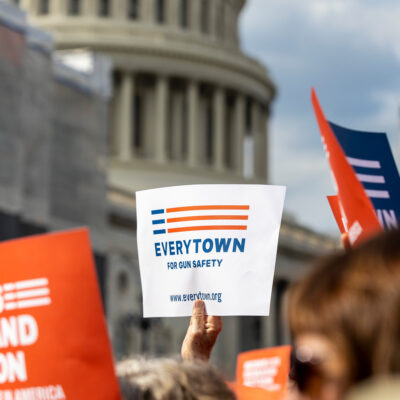United States v. Rahimi

United States v. Rahimi
The Supreme Court issued a life-saving decision in U.S. v. Rahimi—reversing the Fifth Circuit’s dangerous ruling to allow domestic abusers to be armed and confirming that abusers subject to restraining orders do not have a constitutional right to own guns.
The fact that the Court sided against gun rights extremists is a huge win for gun safety and survivors all across the country, but we should not have been here in the first place.
What’s the big question in United States v. Rahimi?
The key question in Rahimi is this: Can the government prohibit domestic abusers subject to restraining orders from possessing firearms?
What did the Supreme Court decide?
On June 21, 2024, the Supreme Court ruled, in an 8 to 1 decision, that the federal law prohibiting domestic abusers subject to protective orders from possessing guns is constitutional under the Second Amendment. In an opinion authored by Chief Justice John Roberts, the Court concluded that “[a]n individual found by a court to pose a credible threat to the physical safety of another may be temporarily disarmed consistent with the Second Amendment.”
“Our tradition of firearm regulation allows the Government to disarm individuals who present a credible threat to the physical safety of others.”
—Chief Justice Roberts, U.S. v. Rahimi Supreme Court majority opinion
In its decision, the Court examined the long history of American gun laws. It found that history “confirm[s] what common sense suggests: When an individual poses a clear threat of physical violence to another, the threatening individual may be disarmed.”1Emphasis added.
What does this decision mean for laws disarming domestic abusers?
The Court’s decision in Rahimi reversed the extreme and deadly decision from the U.S. Court of Appeals for the Fifth Circuit that had struck down 18 U.S.C. 922(g)(8), the federal law disarming domestic abusers subject to restraining orders.
The Court’s decision puts that life-saving law back in place nationwide and confirms that domestic abusers like Zackey Rahimi do not have the constitutional right to possess a gun. And the clear implication is that many other similar laws—including state-law prohibitions on possessing a gun when subject to a domestic violence restraining order, state and federal laws that disarm people convicted of misdemeanor crimes of domestic violence, and extreme risk protection orders—are also consistent with the Second Amendment.
How does this decision affect other gun safety laws?
In its ruling, the Court also provided further insight into how courts should evaluate Second Amendment challenges in the wake of New York State Rifle & Pistol Ass’n v. Bruen, which focused the analysis on whether gun laws are consistent with “this Nation’s historical tradition of firearm regulation.”
In Rahimi, the Court made clear that instead of asking whether a modern gun regulation has a precise historical precursor, courts applying Bruen need only determine “whether the challenged regulation is consistent with the principles that underpin our regulatory tradition.” The Second Amendment, the Court emphasized, is “not … a law trapped in amber” and “was never thought to sweep indiscriminately.” Significantly, the Court expressly rejected the analysis in Justice Thomas’s dissent—and in the Fifth Circuit and other lower courts that have struck down gun laws since Bruen—for requiring a “historical twin” rather than a “historical analogue.”
-
How the Justices Voted
- Chief Justice John Roberts authored the majority opinion, joined by Justices Samuel Alito, Sonia Sotomayor, Elena Kagan, Neil Gorsuch, Brett Kavanaugh, Amy Coney Barrett, and Ketanji Brown Jackson
- Justice Sotomayor filed a concurring opinion, in which Justice Kagan joined
- Justices Gorsuch, Kavanaugh, Barrett, and Jackson filed concurring opinions
- Justice Clarence Thomas was the sole dissenting justice

Why does Rahimi matter?
This decision is life or death for the millions of women, families, and communities across the U.S. who are impacted by the crisis of domestic violence—including the widespread use of guns by abusers.
Access to a gun makes it five times more likely that a woman will die at the hands of a domestic abuser, and every month, 76 women are shot and killed by an intimate partner.
Guns in the hands of abusers not only increase the risk that victims will die, but are also a tool of intimidation—restricting the freedom of women and families, and forcing them to live with fear.
Case background
What led to this case?
In December 2019, a man named Zackey Rahimi allegedly assaulted his ex-girlfriend, identified in the case by her initials, C.M. According to the government’s brief, Rahimi threatened to take away the child they shared. He then knocked C.M. to the ground in the parking lot where they were arguing, dragged her to his car, and shoved her inside—hitting her head on the dashboard in the process.
After realizing that a bystander had seen this assault, Rahimi took out a firearm and shot at the bystander. Rahimi also threatened to shoot C.M. if she told anyone about the assault.
In February 2020, after a hearing in which Rahimi appeared, a Texas state court granted C.M. a two-year protective order from Rahimi. The court issued the order after it found that Rahimi had “committed family violence” and that this violence was “likely to occur again in the future.”
But although Rahimi participated in the hearing and signed an acknowledgment that he had “received a copy of this protective order,” he ignored it. While prohibited by the protective order from having guns or approaching C.M., he allegedly:
- Approached C.M.’s house in the middle of the night;
- Threatened another woman with a gun; and
- Fired a gun in five separate incidents in the span of two months.
During a search of his home, police found magazines, ammunition, two guns, and a copy of the protective order prohibiting Rahimi from having firearms.
As a result, a federal grand jury indicted Rahimi and he pleaded guilty and was convicted of violating the federal law that bars abusers subject to protective orders from possessing guns.
Why did the Rahimi case go to the Supreme Court?
Before pleading guilty, Rahimi moved to dismiss the criminal charges against him, arguing that 18 U.S.C. 922(g)(8)—the law at the heart of the Rahimi case—violates the Second Amendment. The district court rejected that argument because controlling, pre-Bruen case law had upheld 922(g)(8) as constitutional. The Fifth Circuit Court of Appeals originally affirmed for the same reason.
But after the Supreme Court ruled in New York State Rifle & Pistol Association v. Bruen, the Fifth Circuit reopened Rahimi’s case and reversed its decision. The court said that, although Rahimi was “hardly a model citizen,” the government could not constitutionally disarm him on the ground that he was subject to a protective order.
Wait, why did Bruen change anything?
The Supreme Court’s ruling in Bruen, among other things, introduced a new historical test for evaluating Second Amendment cases that requires the government to establish that a challenged gun law is “consistent with this Nation’s historical tradition of firearm regulation.”
Judges must decide whether our current laws are analogous to historical laws and tradition ranging back as many as 150 to 250 years ago. Because laws specifically disarming domestic abusers didn’t exist in the 18th century, the Fifth Circuit effectively reasoned, Rahimi’s conviction could not stand.
National Domestic Violence Hotline
If you or someone you know is experiencing domestic violence, please contact the National Domestic Violence Hotline by calling 1-800-799-SAFE (7233), texting “START” to 88788, or chatting online at thehotline.org. Trained advocates are available 24/7 to provide free confidential support to people anywhere in the US.
You can also find more resources on legal assistance in English and Spanish at WomensLaw.org. For additional resources on the emotional, medical, financial, and legal consequences of gun violence for individuals and communities, please visit Everytown’s Resources page.
Click here for additional resources for survivors of domestic violence and intimate partner violence.




